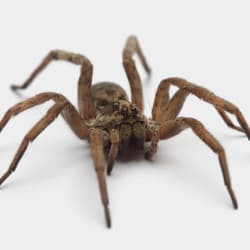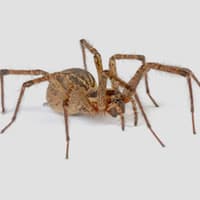Have you seen a wolf spider? Would you know one if you saw one? There are actually around 200 species of wolf spider found in North America, and they don’t all look the same. The most common wolf spider we see in Tennessee homes is brown with two dark parallel lines on the back of its head. This spider is sometimes mistaken for a grass spider, and your grass is actually where it prefers to be. But, all too often, it finds its way into places it does not belong, or even particularly want to be, because, unlike the grass spider, wolf spiders don’t hang out in webs and wait for their food to come to them. In fact, they don’t make webs at all. They prowl for their food.
Wolf spiders are drawn to moist or humid areas, and places where they can get a meal. This will bring them into garages, sheds, and basements in search of crickets, cockroaches, beetles, flying insects, and more. While it may be nice to think about having a creature taking care of these other pests in your home, it is better to have all the pests removed from your home.
The bite from a wolf spider is not medically important, but it does hurt, and it can leave you with a red, itchy welt. For those who are allergic to the venom of a wolf spider, it can take several days for this wound to heal. In all cases, it is possible to get a secondary infection if a wolf spider bite isn’t properly treated.
Wolf Spider Control
-
Reducing insects around your home can reduce wolf spiders. Make sure all exterior trash is sealed, and consider replacing outside lights with yellow insect-resistant bulbs, or simply keep them off.
-
Removing vegetation that is near your exterior walls can deter these spiders from exploring where you don’t want them to be.
-
If they get on your wall, it is important to make sure they don’t find an entry point. Repair or replace any damaged or missing screens on your home, and use a caulking gun to fill in any holes that have developed in your exterior walls.
-
Remove clutter that is next to your walls.
-
Make sure your doors have working door sweeps.
-
Reduce the humidity in your basement and other areas these spiders may explore.
-
Have a professional pest controller give your home year-round protection.
There are a lot of bugs that try to get into Tennessee homes this time of year, and wolf spiders are one of them. Make sure your home is protected with a year-round, seasonal pest control you can trust. Find out about our Power, Power Gold, and Power Platinum pest plans, and how they guard against over 30 common household pests.
You can probably live with wolf spiders–but it nicer to live without them. Get your quality of life upgrade today.

